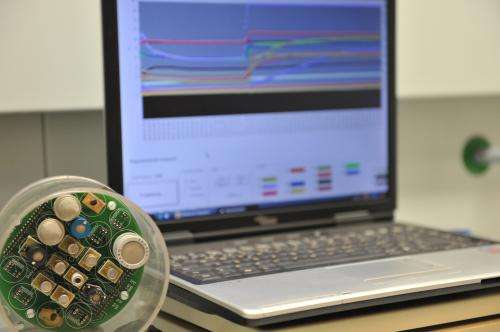Electronic 'noses' to detect chemical warfare gases

Researchers of the Universitat Politècnica de València have developed a prototype of electronic "nose" for the detection of chemical warfare gases, fundamentally nerve gases (Sarin, Soman and Tabun).
The "nose" consists of fifteen commercial sensors, a data acquisition system and a computer connected to this system. Through the sensors, the nose "smells" or registers the gases in the environment and then it processes the data obtained using a recognition pattern, in order to warn of the presence of one gas or another.
"The system registers the signs of gas through metal oxide semiconductor sensors (MOS), which respond to gases in a characteristic way. Then, the signs obtained are mathematically processed to obtain the different recognition patterns to discriminate between the different gases we have worked with", says Ramón Martínez Máñez, head of the Institute of Molecular Recognition and Technological Development of the Universitat Politècnica de València.
According to the researchers, there are detection systems already on the market, but the most of them are based on physical or enzymatic methodologies and have some deficiencies such as a low selectivity, in addition to being rather costly.
"The use of the electronic nose technology aims to create a device that detects these warfare gases in an efficient, quick, simple and cheap way", says Cristian Olguín, researcher at the Institute of Molecular Recognition and Technological Development of the Universitat Politècnica de València.
With regard to its possible formats, Ramón Martínez Máñez explains that these devices could be both portable, to take measures in concrete settings where a chemical attack is suspected, and fixed, for a continuous environment monitoring.
"In the future, they could be used, for example, in transport infrastructures such as airports or train stations, as well as in other national security services", adds Martínez Máñez.
In order to test the performance of their devices, the researchers performed different tests in the laboratory using gas simulants, which react in the same way but are less toxic. "The results prove that this technology is already mature and it would be very useful in the security sector, although there are still many steps to be taken before it is commercially implemented", says Martínez Máñez.
More information: Cristian Olguín, Nicolás Laguarda-Miró, Lluís Pascual, Eduardo García-Breijo, Ramón Martínez-Mañez, Juan Soto, "An electronic nose for the detection of Sarin, Soman and Tabun mimics and interfering agents." Sensors & Actuators B: Chemical. DOI: 10.1016/j.snb.2014.05.060
Provided by Asociacion RUVID


















